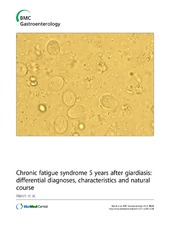| dc.contributor.author | Mørch, Kristine | en_US |
| dc.contributor.author | Hanevik, Kurt | en_US |
| dc.contributor.author | Rivenes, Ann Christin | en_US |
| dc.contributor.author | Bødtker, Jørn | en_US |
| dc.contributor.author | Næss, Halvor | en_US |
| dc.contributor.author | Stubhaug, Bjarte | en_US |
| dc.contributor.author | Wensaas, Knut-Arne | en_US |
| dc.contributor.author | Rørtveit, Guri | en_US |
| dc.contributor.author | Eide, Geir Egil | en_US |
| dc.contributor.author | Hausken, Trygve | en_US |
| dc.contributor.author | Langeland, Nina | en_US |
| dc.date.accessioned | 2014-08-22T08:41:36Z | |
| dc.date.available | 2014-08-22T08:41:36Z | |
| dc.date.issued | 2013-02-12 | eng |
| dc.identifier.issn | 1471-230X | |
| dc.identifier.uri | https://hdl.handle.net/1956/8318 | |
| dc.description.abstract | Background: A high prevalence of chronic fatigue has previously been reported following giardiasis after a large waterborne outbreak in Bergen, Norway in 2004. The aim of this study was to describe and evaluate differential diagnoses and natural course of fatigue five years after giardiasis among patients who reported chronic fatigue three years after the infection. Methods: Patients who three years after Giardia infection met Chalder’ s criteria for chronic fatigue (n=347) in a questionnaire study among all patients who had laboratory confirmed giardiasis during the Bergen outbreak (n=1252) were invited to participate in this study five years after the infection (n=253). Structured interviews and clinical examination were performed by specialists in psychiatry, neurology and internal medicine/infectious diseases. Fukuda et al’s 1994 criteria were used to diagnose chronic fatigue syndrome (CFS) and idiopathic chronic fatigue (ICF). Self-reported fatigue recorded with Chalder Fatigue Questionnaire three and five years after infection were compared. Results: 53 patients were included. CFS was diagnosed in 41.5% (22/53) and ICF in 13.2% (7/53). Chronic fatigue caused by other aetiology was diagnosed in 24.5% (13/53); five of these patients had sleep apnoea/hypopnoea syndrome, six had depression and five anxiety disorder, and among these two had more than one diagnosis. Fatigue had resolved in 20.8% (11/53). Self-reported fatigue score in the cohort was significantly reduced at five years compared to three years (p<0.001). Conclusion: The study shows that Giardia duodenalis may induce CFS persisting as long as five years after the infection. Obstructive sleep apnoea/hypopnoea syndrome, depression and anxiety were important differential diagnoses, or possibly comorbidities, to post-infectious fatigue in this study. Improvement of chronic fatigue in the period from three to five years after giardiasis was found. | en_US |
| dc.language.iso | eng | eng |
| dc.publisher | BioMed Central | eng |
| dc.rights | Attribution CC BY | eng |
| dc.rights.uri | http://creativecommons.org/licenses/by/2.0 | eng |
| dc.subject | Giardia | eng |
| dc.subject | Chronic fatigue syndrome | eng |
| dc.subject | Depression | eng |
| dc.subject | Anxiety | eng |
| dc.subject | Sleep apnoea hypopnea syndrome | eng |
| dc.title | Chronic fatigue syndrome 5 years after giardiasis: differential diagnoses, characteristics and natural course | en_US |
| dc.type | Peer reviewed | |
| dc.type | Journal article | |
| dc.date.updated | 2013-08-23T08:54:42Z | |
| dc.description.version | publishedVersion | en_US |
| dc.rights.holder | Copyright 2013 Mørch et al.; licensee BioMed Central Ltd. | |
| dc.rights.holder | Kristine Mørch et al.; licensee BioMed Central Ltd. | |
| dc.source.articlenumber | 28 | |
| dc.identifier.doi | https://doi.org/10.1186/1471-230x-13-28 | |
| dc.identifier.cristin | 1011638 | |
| dc.source.journal | BMC Gastroenterology | |
| dc.source.40 | 13 | |

